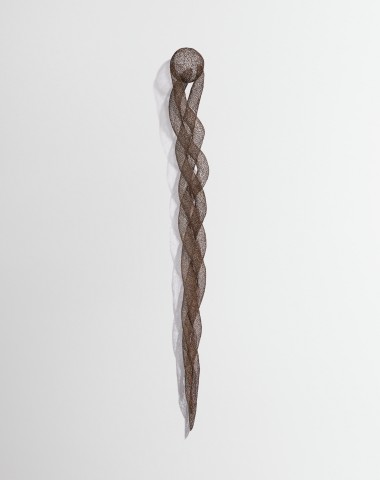CLASP, 2006
BRONWYN OLIVER
copper
215.0 x 20.0 x 20.0 cm
Estate of the artist, Sydney
Private collection, Italy, from 2009
Menzies, Melbourne, 9 February 2017, lot 34
Private collection, Sydney
Bronwyn Oliver (1959 – 2006), Roslyn Oxley9 Gallery, Sydney, 10 August – 2 September 2006
Fink, H., Bronwyn Oliver: Strange Things, Piper Press, Sydney, 2017, p. 221 (as ‘Clasp II’)
‘When the ideas, the formal elements and the medium all work together, a sculpture will ‘sing’ with a kind of rightness. It takes on a life, a presence, which is removed from this world. It belongs to a mythical other life, without a place in time.’1
One of Australia's most innovative contemporary sculptors, Bronwyn Oliver remains celebrated for her extraordinary ability to produce meticulously articulated works of immense beauty and grace which unite timeless, organic forms of the natural world with the abstract logic of geometry. As elucidated by Hannah Fink in her introduction to the artist’s posthumous exhibition at Roslyn Oxley9 Gallery in August 2006 which notably featured the present Clasp, 2006, ‘...Bronwyn was modest, yet utterly sure of her vision, secure in the confidence of her originality. Her art was fully resolved – perfect, really – and she stands alone in the annals of Australian art history. There was no-one like her: she invented her own deeply intelligent form, and entered fully into the world that it opened out to her.’2
Created only months before her untimely death in 2006, Clasp offers a superb, albeit poignant, example of Oliver’s delicately woven copper and bronze assemblages that universally seek to surprise and inspire – beguiling both the eye and mind through their enigmatic presence. Arguably echoing the paradoxes inherent within the artist own personality3, her works are simple yet complicated, fragile yet strong, eccentric though oddly straightforward. Moreover, with their tactility and anatomical physicality, such intricately executed forms invariably elicit a temptation to touch – the sensual, prehistorically scaled versions of natural phenomena thus reminding us that the world is a corporeal place.
Yet too often the easy, sensual curves of Oliver's objects belie the punishing, labour intensive process to which the artist was so tenaciously committed. As intimated by the present sculpture’s allusive title meaning to hold tightly or to fasten something with one’s hands, Oliver would painstakingly manipulate dizzying twistings and welds of pliant copper wire to create her signature ‘weave’ – the microstructure of her organic sculptural forms which gradually became more open and geometric to allow light to permeate and exaggerate their optical aspect. Indeed, the shadows cast by her objects – whether vertically mounted, flowing tendril shapes (such as the present sculpture), calligraphic sweeping curves, or seed and pod-like spheres – are so intrinsic to the formalist geometry of each piece that at times the shadow itself almost becomes more powerful... becomes the object.4 Evoking a duality between that which is immobile and inert, yet also active and dynamic, thus the interplay between these aspects suggests, as Natasha Bullock notes, ‘… a passage from one place to another, a journey from a material dimension into an imaginative other world.’5
Elegant and refined, Clasp encapsulates well Oliver’s unique legacy of beauty, wonder, strength and life – her skilful mastery of form, space and material to create flawless sculptural works that, although unmistakably contemporary in their construction, simultaneously betray a timeless, ethereal quality that resonates deeply within the human soul.
1. Oliver cited in Sturgeon, G., ‘Bronwyn Oliver’, Contemporary Australian Sculpture, Craftsman House, Sydney, 1991, p. 74
2. Fink, H., ‘Exhibition Essay’ in Bronwyn Oliver (1959 – 2006), Roslyn Oxley9, Sydney, 2006, see: https://www.roslynoxley9.com.au/exhibition/bronwyn-oliver-1959-2006/46saa
3. ibid.
4. ibid.
5. Natasha Bullock cited in Bond, A. and Tunnicliffe, W., (eds.), Contemporary: Art Gallery of New South Wales Contemporary Collection, Art Gallery of New South Wales, Sydney, 2006, p. 326
VERONICA ANGELATOS
